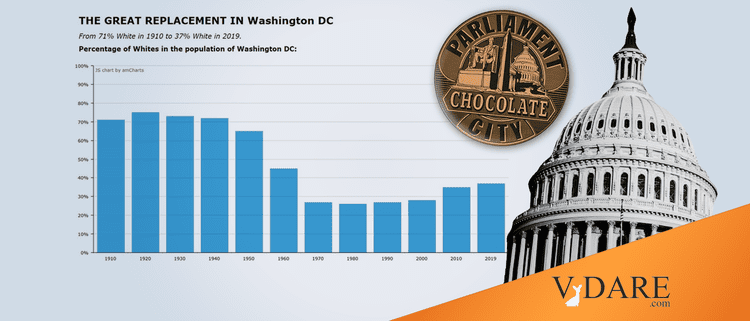


05/04/2020
By Gregory Hood, Henry Wolff, and Paul Kersey, American Renaissance, April 6, 2020
This is the second in a series about the continuing disappearance of whites from American cities (see the first, about Birmingham, Alabama, here). Many people still pretend that The Great Replacement is a myth or a conspiracy theory, but the graphs that accompany each article in this series prove them wrong. Every city has a different story but all have seen a dramatic replacement of whites by minorities.
The District of Columbia began as a Southern city. Thomas Jefferson and James Madison won the prize of hosting the capital in exchange for the federal government’s assumption of state debts. In retrospect, this was a bad deal for Virginia. Like the Plantation of Protestant Ulster in Catholic Ireland, Washington DC became a base for colonization. Today, Northern Virginia is lost to Dixie.
This became clear only recently. “Our hometown was the sleepy and segregated southern city Washington D.C.,” wrote Pat Buchanan in his autobiography.” The capital always had blacks, including slaves and their descendants, but the “quiet pleasant place” Mr. Buchanan describes had a large white majority.
In 1953, the Supreme Court ruled in District of Columbia v. John R. Thompson Co. that segregation in the capital was unconstitutional. A year later, in Brown v. Board of Education, the court banned segregated schools. These rulings drove many whites to the suburbs, and by 1960, the capital was majority black. In 1968, blacks rioted after Martin Luther King Jr. was assassinated, driving out more whites.

According to the United States Constitution, Congress has complete power over the District, so after Washington became majority black, “home rule” became a civil rights issue. Blacks did not want to be governed by whites in Congress. In 1973, President Richard Nixon signed a “home rule” act that gave local authorities more power. Many Democrats want DC statehood, but most Americans don’t.
In 1975, the black funk band Parliament released its third album, “Chocolate City.” The name stuck, and it became DC’s nickname.
In 1979, Marion Barry became mayor. He was in office until 1991, presiding over a corrupt, crime-ridden city. In 1992, Jared Taylor reviewed a book about DC under Marion Barry, and called the review “Kinshasa on the Potomac.” The spectacle of the capital of the free world under Barry tested the strongest stomachs.
There was a brief interruption in Barry’s political career when he was convicted for smoking crack. After he got out of the pen, he ran for the DC Council from Ward 8, and was elected in 1992. In 1994, he won another term as mayor, serving until 1999. Ward 8, which is still 92 percent black, sent him back to the DC Council from 2005 to 2014. Only death removed him from office; the city honored him with a statue.
By the time he died, Marion Barry was a relic, because after 2000, the city began gentrifying. Whites returned. Crime dropped. Property values rose. Journalists, of course, mourned:
If these articles were about whites who didn’t want to become a minority, the authors would call them “conspiracy theorists.”
Unfortunately, the whites who are coming back will not turn Washington back into a Southern town. They work for the federal government; more than 90 percent of the district voted for Hillary Clinton in 2016. “Chocolate City” may be gone, but Leviathan on the Potomac remains. If he cared about Virginia, putting the city in his state was Thomas Jefferson’s greatest mistake.